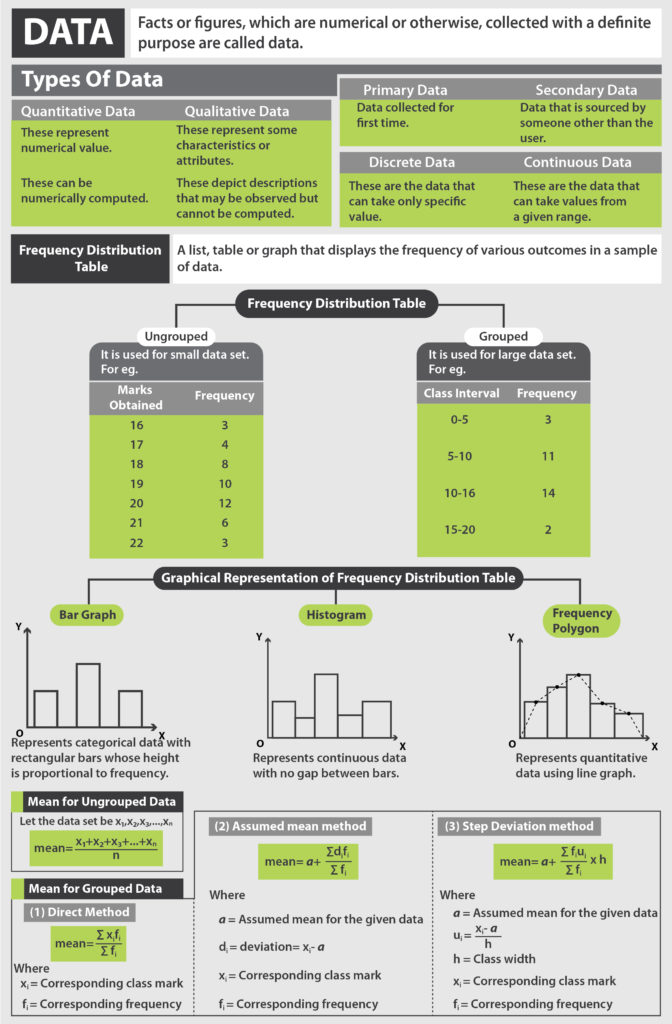We do not generally associate data with mathematics. However, data is the base of all operations in statistics. So let us learn more about data collection, primary data, secondary data, and a few other important terms.
Suggested Videos
What is Data?

Data can be defined as a systematic record of a particular quantity. It is the different values of that quantity represented together in a set. It is a collection of facts and figures to be used for a specific purpose such as a survey or analysis. When arranged in an organized form, can be called information. The source of data ( primary data, secondary data) is also an important factor.
Types of Data
Data may be qualitative or quantitative. Once you know the difference between them, you can know how to use them.
- Qualitative Data: They represent some characteristics or attributes. They depict descriptions that may be observed but cannot be computed or calculated. For example, data on attributes such as intelligence, honesty, wisdom, cleanliness, and creativity collected using the students of your class a sample would be classified as qualitative. They are more exploratory than conclusive in nature.
- Quantitative Data: These can be measured and not simply observed. They can be numerically represented and calculations can be performed on them. For example, data on the number of students playing different sports from your class gives an estimate of how many of the total students play which sport. This information is numerical and can be classified as quantitative.

Source: Wiki Images
Data Collection
Depending on the source, it can classify as primary data or secondary data. Let us take a look at them both.
Primary Data
These are the data that are collected for the first time by an investigator for a specific purpose. Primary data are ‘pure’ in the sense that no statistical operations have been performed on them and they are original. An example of primary data is the Census of India.
Download the Cheat Sheet of Statistics by clicking on the button below

Browse more Topics Under Statistics
- Data
- Mean
- Median
- Mode
- Bar Graphs and Histogram
- Cumulative Frequency Curve
- Frequency Distribution
- Frequency Polygon
- Range and Mean Deviation
- Range and Mean Deviation for Grouped Data
- Range and Mean Deviation for Ungrouped Data
- Variance and Standard Deviation
Statistics
Secondary Data
They are the data that are sourced from someplace that has originally collected it. This means that this kind of data has already been collected by some researchers or investigators in the past and is available either in published or unpublished form. This information is impure as statistical operations may have been performed on them already. An example is an information available on the Government of India, the Department of Finance’s website or in other repositories, books, journals, etc.
Learn how to find the Mode of the data and its relationship with the Median and Mean here.
Discrete and Continuous Data
Discrete Data: These are data that can take only certain specific values rather than a range of values. For example, data on the blood group of a certain population or on their genders is termed as discrete data. A usual way to represent this is by using bar charts.
Continuous Data: These are data that can take values between a certain range with the highest and lowest values. The difference between the highest and lowest value is called the range of data. For example, the age of persons can take values even in decimals or so is the case of the height and weights of the students of your school. These are classified as continuous data. Continuous data can be tabulated in what is called a frequency distribution. They can be graphically represented using histograms.
Learn How to represent data in Bar Graphs and Histogram here.
Solved Example for You
Question 1: A dataset is as follows: {3, 8, 7, 4, 6, 1, 5}. Calculate the range of this set.
Answer: Range is a statistical measure that estimates the difference between the highest and lowest values from a dataset. Here, range = 8-1 = 7.
Question 2: What is data?
Answer: Data refers to a systematic record of a specific quantity. It is the diverse values of that quantity together which the sets represent. In other words, it is a set of facts and figures which are useful in a particular purpose like a survey or an analysis. Moreover, when you arrange them in an organized form, they refer to as information. Moreover, the source of data primary or secondary is also an essential factor.
Question 3: What are the two types of data?
Answer: Data can be classified as qualitative and quantitative. Qualitative data represents some characteristics or attributes. Further, they represent descriptions which we may observe that we cannot compute or calculate. For instance, data on attributes like intelligence, creativity, honesty, cleanliness, wisdom, and more are examples of qualitative data. In other words, they are more exploratory than conclusive.
Further, there is quantitative data which we can measure and not just observe. You can represent them numerically and even perform calculations. For instance, the number of students in basketball will be numerical, thus, it is quantitative data.
Question 4: What is Primary Data?
Answer: Primary data is one which an investigator collects for the first time for a particular purpose. Further, this data is ‘pure’ in the sense that there haven’t been any statistical operations performed on them, plus they are also original. The Census of India is an example of primary data.
Question 5: What s discrete data?
Answer: Discrete data is one which can take into consideration only certain specific values instead of a range of values. For instance, data which is on the blood group of a specific population or on their genders is known as discrete data. Also, bar charts are a common way to represent this data.







Leave a Reply